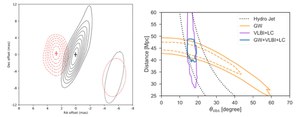Measuring the Hubble Constant Via Superluminal Motion
 The Hubble constant (H0) measures the current expansion rate of the Universe, and plays a fundamental role in cosmology. Enormous effort has been dedicated over the past decades to measure H0. Notably, Planck cosmic microwave background and the local Cepheid-supernovae distance ladder measurements determine H0 with a precision of ∼1% and ∼2% respectively. A 3σ level of discrepancy exists between the two measurements, for reasons that have yet to be understood
The Hubble constant (H0) measures the current expansion rate of the Universe, and plays a fundamental role in cosmology. Enormous effort has been dedicated over the past decades to measure H0. Notably, Planck cosmic microwave background and the local Cepheid-supernovae distance ladder measurements determine H0 with a precision of ∼1% and ∼2% respectively. A 3σ level of discrepancy exists between the two measurements, for reasons that have yet to be understood
Gravitational wave (GW) sources accompanied by electromagnetic (EM) counterparts offer an independent, “standard siren” measurement of H0, as demonstrated following the discovery of the neutron star merger, GW170817. This measurement does not assume a cosmological model and is independent of a cosmic distance ladder. The first joint analysis of the GW signal from GW170817 and its EM localization led to a measurement of H0 = 74+16−8 km/sec/Mpc.
In this analysis, the degeneracy in the GW signal between the source distance and the observing angle dominated the H0 measurement uncertainty. Recently, Mooley at al. (Nature 561, 355, (2018)) obtained tight constraints on the observing angle using high angular resolution imaging of the radio counterpart of GW170817 have been obtained. In this contribution, Hotokezaka et al. report an improved measurement H0 = 70.3+5.3−5.0 km/sec/Mpc by using these new radio observations, combined with the previous GW and EM data. The authors estimate that just 15 more GW170817-like events, having radio images and light curve data, will potentially resolve the tension between the cosmic microwave background and Cepheid-supernova measurements, as compared to 50-100 GW events without such data.
IMAGE: [Left] Proper motion of the VLBI components of GW170817 at 5 GHz over 155 days. [Right] Distance to the source versus rotation plane for the merger, from which the Hubble constant can be derived (K. Hotokezaka et al. 2019).
Publication: Hotokezaka, Kenta (Princeton University) et al., A Hubble Constant Measurement from Superluminal Motion of the Jet in GW170817, Nature Astronomy, 3, 940 (8 July 2019).
NRAO Press Release: New Method May Resolve Difficulty in Measuring Universe's Expansion




Connect with NRAO